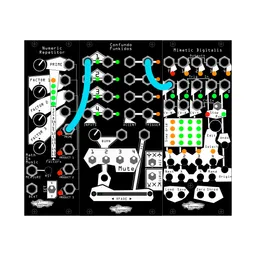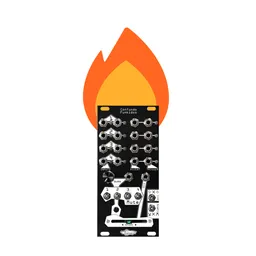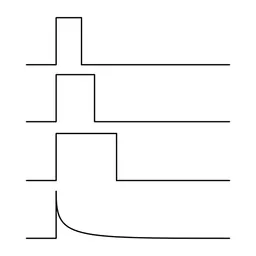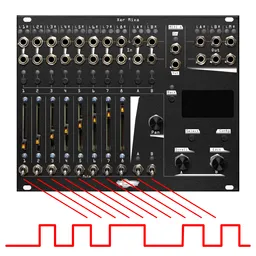Making a patch sound musical can be difficult. Creating a nice bassline, for instance, is one thing, but making it sound musical, especially when repeating, requires some more thought. Luckily, there are a lot of ways to do this, and you probably have the modules you need to do it already in your rack. Let’s discuss!
What is humanization?
This is a term that gets thrown around a lot, especially in the DAW world, but what does it mean? Here, we’re using it to refer to randomization that makes things sound more natural. Think about it: if you’re playing an instrument, like a violin or a guitar, each time you play a note it sounds different in subtle ways, even if it’s the same note. In general, those changes will be in pitch, volume, and timbre. Notes also generally won’t be perfectly timed. Humans are not, on the whole, great at being on the grid 100% of the time.
Here’s the thing: I’ve tried adding very slight randomization to the pitch inputs on my oscillators, and it always just sounds a bit too coarse and non-musical to my ears. It may work for you, but it’s not my first choice for melodic humanization. If you do want to give it a try, be VERY subtle with it. I’m a fan of running signals through multiple attenuators in series to increase precision. In Eurorack, a semitone is about .083 volts. That means that even a few millivolts will have a relatively significant change, so attenuate away and make your pitch changes subtle, unless you want to completely change your melody.
Timing is one of my favorites to play with: if you read our post about creating sequences with variable step length you’ll already have an idea of how to play with time in a sequence, and you can expand on the concepts in that post by using a random CV source instead of a regular CV sequencer to adjust your sequence timing. If you have a gate delay with a CV input, you can also use any of the techniques below to vary the timing of your sequence a bit, too. CV-able gate delays are especially useful as they can be put on top of a normally clocked sequencer to create unusual timing from its sequences. They also may be more common than you think: I realized I already had a few in my system without even realizing it as both my Mutable Instruments Stages and 2HP Burst can act as CV-controlled gate delays.
Timbre, however, is my favorite type of parameter to “humanize” by far. Let’s look at something like a drum made with the BIA. Fold, while a very aggressive effect at its higher values, can create some really subtle changes in the first 10% of its range. This means subtle modulation to that CV input can be great, even if you’re using a clean kick. Harm and Morph are also great modulation destinations, and again, sending them something subtle will create some nice variety.
But that’s not all: we can play with dynamics, too. We can emulate different strength hits by modulating the decay time, and the volume by running it through a VCA.
And of course, we can apply these techniques to any other sound in our system as well. If we have a basic subtractive patch playing a bassline, we can subtly modulate the filter’s cutoff on each note for some freshness in our sequence. The possibilities are endless!
Learn more:
How do I humanize?
I often like using a single control signal, making a bunch of copies with a mult, and then attenuating them and running them to a bunch of destinations to create really subtle modulation over time. But where should these signals come from?
Random CV
There are a lot of ways of getting random CV in Eurorack. Like, so many. Of course, there are dedicated random CV generators like Mimetic Sequent, Clep Diaz, Mutable Instruments’ Marbles, Make Noise’s Wogglebug, Doepfer’s A-149-1...the list goes on. If I’m going to be using a dedicated random source, I really like Clep Diaz in LFO mode. You can clock it, so it’ll be related to your sequence, but it’s still got a lot of variation in what it’ll do with that clock input. It’s a great one for creating evolving sequences, but remember, the outputs are 0-5v/-5-5v so you’ll want to attenuate them. Subtlety is key here.
Sample and Hold
The most traditional way of getting a random CV signal is by running noise into a sample and hold. This gives you a new random CV value every time the S&H is triggered, but it’s not my favorite: it’s a bit too random for my taste a lot of the time. With some processing, though, it can be made more usable: running stepped voltages through a slew (even a fast one) makes the changes less abrupt, and can make changes less startling. And, of course, some attenuation makes it much more manageable.
LFOs
We also don’t have to use a random signal to make things sound somewhat random. A slow LFO of any shape can be a good choice, especially one that isn’t synced to your sequencer at all. Attenuate to taste, patch it in a bunch of places, and you’ll get some nice evolving changes over time. And you can make things even more random sounding by running two LFOs into a VCA: one into the input, and one into the CV in. This will make your LFOs shapes much more complex, without a whole lot of effort. And you can still mult out both LFOs for use in other places in your patch!
Again, be subtle
I’ve mentioned it a few times here, but we need SMALL changes for this to sound musical and not like a completely random cacophony. (But hey, let’s be real, if you want to go all out with the random and modulate all the things with all the CV, I won’t stop you… ) For our purposes here, attenuators are a very useful tool. And especially when using something like a gate delay, small changes will go a long way. If your goal is purely humanization, tiny changes are what you want.
Modulation destinations
I often find that modulating quite a few destinations in a patch just a tiny bit is the key to getting things to sound musical. A Sinc Defero is great for this, as it mults a signal up to four times and lets you attenuate each copy separately (or just attenuate four separate signals). Filters are always a great choice when applicable, and sometimes I use modulated filters like notches on top of things that don’t necessarily need filtering just to slightly change their sound and allow me to add in some timbral variety. Any patches involving wavefolders shine with modulation like this, as do complex oscillators -- my Cs-L and Loquelic Iteritas always have their CV inputs full.
Let’s try this out! Here, I’ve used a single Clep Diaz and multed it to Lapsus Os’s attenuation inputs. From there, it modulates my reverb, my synth voice, my kick, and the gate delays for my synth voice and hat. Fine-tuning the subtle modulation with Lapsus Os makes the patch come alive.






